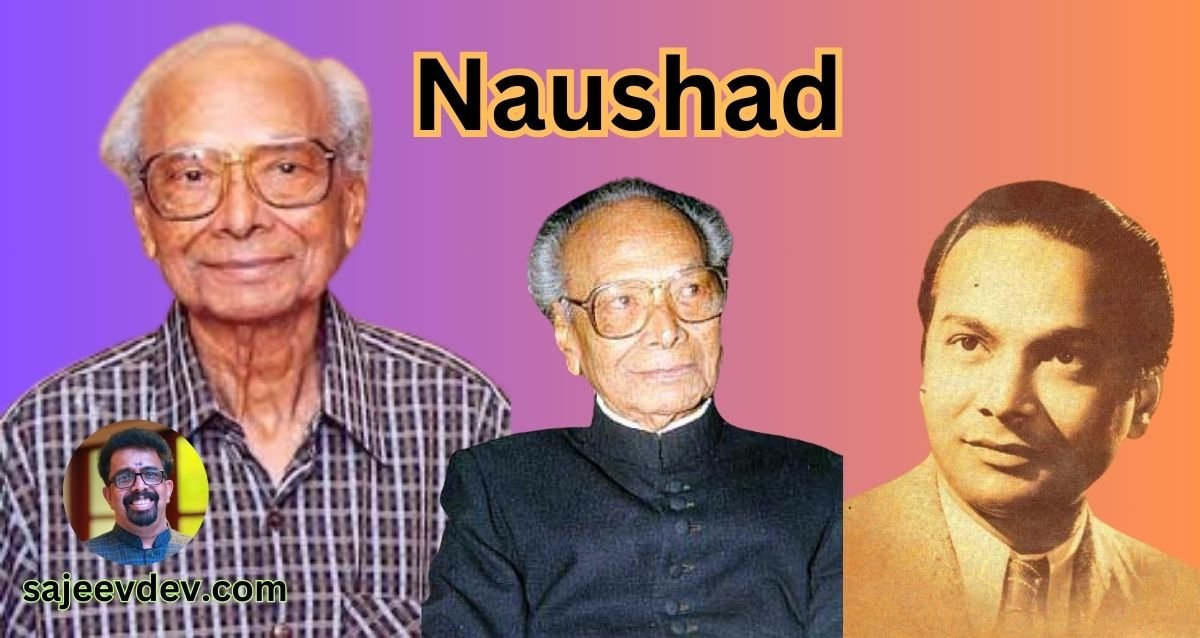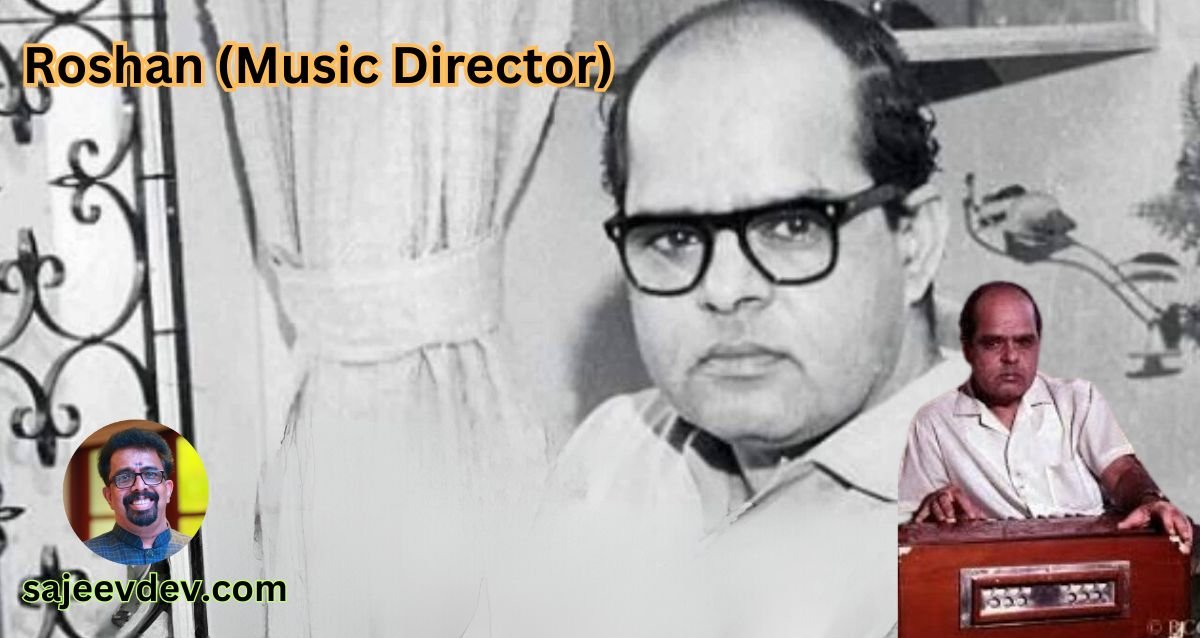Naushad and His Legacy
Naushad Ali, born in 1919 in Lucknow, India, is widely regarded as one of the foundational pillars of Hindi cinema music. His illustrious career spanned several decades during which he composed unforgettable melodies that continue to charm listeners to this day. Naushad’s contributions to the industry are not just marked by his musical genius but also by his innovative ability to blend traditional Indian classical music with the evolving melodies of popular film tunes. His work symbolizes a perfect amalgamation of heritage and modernity, an art that remains unparalleled.
Naushad’s entry into the world of films occurred during an era when the Hindi film industry was still in its nascent stages. The films of that time relied heavily on songs not merely as filler content but as integral components that often dictated the movie’s emotional and narrative flow. Naushad tapped into the rich reservoir of Indian classical music, infusing it with contemporary styles to create compositions that resonated deeply with audiences. His music was not just about entertainment; it was an experience that transported the listener to a realm of sheer auditory delight.
Throughout his career, Naushad collaborated with some of the greatest playback singers and lyricists of his time. Notable films like “Mughal-e-Azam,” “Baiju Bawra,” and “Mother India” are a testament to his remarkable ability to craft music that was both evocative and timeless. His scores were meticulously orchestrated, often featuring grand arrangements and intricate melodies that reflected his deep understanding of ragas and talas, intrinsic elements of Indian classical music.
Beyond his compositions, Naushad’s influence extended into the nurturing of talent within the industry. He was instrumental in shaping the careers of several successful musicians and singers. His legacy is woven into the very fabric of Hindi cinema, making him a name that is synonymous with musical excellence and innovation. Even years after his passing in 2006, Naushad’s music continues to be celebrated, his compositions studied, and his contributions lauded as cornerstones of Hindi film music.“`html
Early Life and Musical Journey
Naushad Ali, born on December 25, 1919, in the culturally rich city of Lucknow, emerged as an iconic figure in the world of Hindi cinema music. Lucknow, known for its deep-rooted traditions in classical music, played an instrumental role in shaping Naushad’s musical inclinations. From a young age, his environment brimmed with musical influences, fostering an innate passion for music.
Naushad’s early life unfolded in a household that was skeptical of his musical aspirations. Despite this opposition, determination and talent propelled him towards a career in music. His enthusiasm often found him attending local music concerts, where he imbibed classical ragas and traditional rhythms. The budding musician soon found solace and mentorship under Ustad Ghurbat Ali, Ustad Yusuf Ali, and his confidant, Ustad Babban Saheb. These early mentors equipped him with foundational knowledge in classical music that became the cornerstone of his future compositions.
Chasing his dreams, Naushad moved to Mumbai (then Bombay) in the late 1930s, a daunting step toward mainstream cinema. The city offered opportunities but was equally harsh to newcomers. The young musician struggled initially, stationed often in dingy lodgings while searching for a breakthrough. He played small roles in orchestras and occasionally composed music for lesser-known theatre productions. Persisting through these challenging times, Naushad’s resilience led him to forge connections within the industry as he continued to refine his craft.
His significant break came with the film “Prem Nagar” in 1940, where his distinct musical style caught the attention of industry stalwarts. This project marked the beginning of Naushad’s illustrious journey, propelling him to compose for numerous landmark films and cementing his legacy as a maestro. From this point, Naushad’s career ascended rapidly, characterized by timeless melodies that continue to resonate with audiences today.
Breakthrough and Rise to Stardom
Naushad Ali’s journey into the limelight began in the early 1940s, a period when the Hindi film industry was experiencing a transformative phase. He made his mark with the film “Rattan” (1944), which became a spectacular success. The music of “Rattan” resonated deeply with audiences, making Naushad a household name. The success of this film was attributed to his innovative approach of integrating classical music traditions with contemporary film music, a blend that was both refreshing and captivating.
Following “Rattan,” Naushad’s repertoire continued to grow, with each composition further solidifying his standing in the industry. Films such as “Anmol Ghadi” (1946) and “Shahjahan” (1946) showcased his ability to craft melodies that were rich in classical nuances yet accessible to the masses. “Anmol Ghadi,” in particular, featured songs that have endured the test of time, becoming evergreen classics celebrated for their lyrical beauty and melodic simplicity.
One of Naushad’s most significant breakthroughs came with the film “Mughal-e-Azam” (1960), a monumental project that required a soundtrack as grand as its narrative. Naushad rose to the challenge, composing music that was not only high in classical influence but also infused with a sense of grandeur and opulence befitting the film’s epic scale. Songs like “Pyar Kiya To Darna Kya” and “Mohe Panghat Pe” are exemplary of his ability to blend intricate classical ragas with the emotive storytelling of cinema.
Naushad’s distinct style, characterized by the use of traditional instruments like the sitar, tabla, and harmonium, and his integration of classical ragas, set him apart from his contemporaries. His commitment to preserving the integrity of classical music while adapting it to the narrative needs of cinema created a unique musical paradigm that influenced many composers who followed. Naushad Ali’s early successes laid a solid foundation for what would become one of the most illustrious careers in the history of Hindi cinema music.
Signature Style and Innovations
Naushad, a luminary in the realm of Hindi film music, is celebrated for his unique ability to harmonize Indian classical traditions with the evolving landscape of contemporary cinema. His compositions often reflected a confluence of classical ragas and modern melodies, which set him apart as a distinguished figure in the industry. Naushad’s signature style was characterized by his masterful use of orchestration, where he effortlessly combined the nuances of traditional Indian music with Western musical elements, creating a rich and enduring soundscape.
One of Naushad’s pioneering techniques was his dedication to incorporating traditional Indian instruments into his scores. Instruments such as the sitar, tabla, and harmonium were seamlessly integrated into his compositions, lending an authentic and timeless quality to the music. His adept use of the shehnai, an instrument often associated with classical and folk music, became a hallmark of his work, as heard in iconic films like “Baiju Bawra” and “Mughal-e-Azam.”
Moreover, Naushad’s commitment to classical music was evident in his meticulous selection of ragas, which formed the backbone of many of his compositions. He skillfully intertwined these ragas with popular music trends of the time, ensuring that they resonated with a broader audience while preserving their classical essence. This innovative blend is exemplified in songs like “Mohe Panghat Pe” and “Pyar Kiya To Darna Kya,” where the traditional classical framework is beautifully meshed with the narrative’s demands.
In addition to his musical virtuosity, Naushad’s innovative use of orchestration played a crucial role in his success. He was among the first composers to employ a large orchestra, often featuring strings, brass, and woodwinds, creating a symphonic effect that enhanced the dramatic impact of his film scores. This technique not only added depth and texture to his music but also set a new standard for film compositions in Hindi cinema.
Naushad’s legacy as an innovator and a master of blending classical traditions with contemporary sensibilities remains unparalleled. His ability to consistently produce music that was both culturally rich and widely accessible has left an indelible mark on the history of Hindi cinema.
Iconic Film Contributions
Naushad’s illustrious career in Hindi cinema is marked by his exceptional contributions to some of the most iconic films, notably “Mughal-e-Azam,” “Baiju Bawra,” and “Mother India.” These timeless classics not only elevated the status of Hindi film music but also showcased Naushad’s unparalleled talent in blending traditional Indian classical music with the evolving musical landscape of Bollywood.
“Mughal-e-Azam” (1960) stands as a testament to Naushad’s genius. The film’s soundtrack was a remarkable achievement, with each composition intricately weaving into the grandeur of the epic narrative. Among the standout tracks, “Pyar Kiya To Darna Kya” remains a cultural milestone. Rendered by the legendary Lata Mangeshkar, the song’s fearless expression of love, set against the exquisite backdrop of the Sheesh Mahal, has left an indelible mark on Indian cinema. The song’s elaborate classical nuances and modern flair encapsulate Naushad’s signature style, ensuring its enduring popularity across generations.
In “Baiju Bawra” (1952), Naushad’s mastery of classical music came to the forefront with compositions that mirrored the soul of Indian traditional heritage. “Man Tarpat Hari Darshan Ko Aaj,” sung by Mohammed Rafi, exemplifies this blend. The devotional song, based on Raga Malkauns, not only resonated deeply with audiences but also underscored Naushad’s ability to evoke profound emotions through his music. The film’s soundtrack played an instrumental role in re-establishing the significance of classical music in mainstream Bollywood.
“Mother India” (1957), another landmark film, featured a soundtrack that bolstered its poignant narrative. Naushad’s compositions for this film beautifully captured the resilience and spirit of rural India. Tracks like “Dukh Bhare Din Beete Re Bhaiya” evoke empathy and solidarity, enriching the film’s emotional depth. The songs from “Mother India” continue to resonate, reflecting the socio-cultural ethos of the era while maintaining their relevance through timeless melodies.
Collectively, these films and their soundtracks exemplify Naushad’s extraordinary ability to create music that transcends time, with each song becoming an integral part of India’s cultural fabric. His work has left an enduring legacy, cementing his position as a maestro of Hindi cinema.“`html
Collaborations with Legendary Artists
Naushad Ali, often regarded as a pivotal figure in the realm of Hindi cinema music, forged several prolific collaborations with some of the industry’s most revered artists. Among these, his partnerships with legendary singers and lyricists like Mohammed Rafi, Lata Mangeshkar, and Shakeel Badayuni stand out for producing timeless classics that continue to resonate with audiences even today.
Front and center of Naushad’s illustrious career was his frequent collaboration with Mohammed Rafi. The synergy between Naushad’s compositions and Rafi’s versatile voice was nothing short of magical. Tracks such as “O Duniya Ke Rakhwale” from Baiju Bawra and “Madhuban Mein Radhika” from Kohinoor exemplify their collaboration, showcasing the emotive depth and technical brilliance that defined their joint works. Rafi’s ability to convey a wide range of emotions through his singing was brilliantly complemented by Naushad’s intricate orchestral arrangements.
Lata Mangeshkar, another stalwart of Indian music, also played a key role in Naushad’s success. Their collaboration yielded numerous memorable songs, such as “Pyar Kiya To Darna Kya” from Mughal-e-Azam and “Mohe Panghat Pe” from Baiju Bawra. Naushad’s melodies provided the perfect canvas for Mangeshkar’s angelic voice, resulting in songs that are cherished across generations. The combination of Naushad’s melodic expertise and Mangeshkar’s vocal prowess created a harmony that became the gold standard in Indian cinema.
A significant component of Naushad’s artistic triumphs also lies in his collaboration with lyricist Shakeel Badayuni. The duo’s partnership was responsible for some of the most soul-stirring lyrics set to music. Songs like “Mere Mehboob Tujhe” and “Chaudvin Ka Chand Ho” saw the exceptional blending of Badayuni’s poetic eloquence with Naushad’s evocative music. Their combined efforts were instrumental in shaping the narrative and emotional landscape of Hindi cinema’s musical heritage.
These collaborations exemplify the extraordinary synergy between Naushad and legendary artists like Mohammed Rafi, Lata Mangeshkar, and Shakeel Badayuni. Together, they created a musical legacy that remains unparalleled, cementing Naushad’s status as the true maestro behind the music of Hindi cinema.
Naushad’s illustrious career in Indian cinema as a music composer earned him recognition and accolades from numerous quarters, both nationally and internationally. His ingenious compositions not only resonated with the audience but also left an indelible mark on the music industry, leading him to receive a plethora of awards and honors.
National Awards and Padma Honors
Naushad was a beloved figure in India, and his contributions were acknowledged through several prestigious awards. One of his most significant honors came in 1981 when he was awarded the Padma Bhushan, the third-highest civilian award in the country. This was followed by the Padma Vibhushan in 1992, the second-highest civilian award, recognizing his exceptional and distinguished service in the field of music.
At the national level, Naushad received numerous accolades from the film industry. He was honored with the National Film Award for Best Music Direction in 1961 for the film “Gunga Jumna”. Additionally, he bagged the coveted Filmfare Award for Best Music Director several times, including for timeless classics such as “Baiju Bawra” in 1954 and “Mughal-e-Azam” in 1960, which are often cited among the greatest musical compositions in Hindi cinema.
Lifetime Achievement Awards
Naushad’s enduring legacy in the film industry is celebrated through various lifetime achievement awards. In 1982, he received the Sangeet Natak Akademi Award, recognizing his outstanding contribution to Indian music. Further consolidating his iconic status, the renowned composer was honored with the Dadasaheb Phalke Award in 1982, the highest award in Indian cinema, acknowledging his lifetime contribution to the art of filmmaking.
International Recognition and Tributes
On an international level, Naushad was also feted for his exceptional talent. His work gained recognition and admiration globally, leading him to receive several international accolades. Notably, in 1977, he was invited to present a repertoire of his compositions at the Lincoln Center in New York, an honor rarely bestowed on Indian composers.
Tributes continued to pour in even after his passing in 2006, with various film industry stalwarts and institutions celebrating his prodigious contributions. Naushad’s legacy remains deeply ingrained in the annals of Hindi cinema, cementing his status as a maestro who profoundly shaped the music landscape.
Legacy and Influence on Modern Music
Naushad’s enduring legacy in the realm of Hindi cinema is profound and undeniable. As one of the foremost composers in the history of Indian music, his contributions have left an indelible mark on the industry. His pioneering techniques and melodious compositions have set a benchmark for generations of music directors and composers. Naushad’s influence extends beyond his era, reaching into the modern day where filmmakers and musicians frequently draw inspiration from his body of work. This connection between past and present underscores the lasting relevance of Naushad’s musical legacy in contemporary Indian cinema.
Many modern composers attribute a significant portion of their musical style to Naushad’s extensive and varied catalogue. His mastery in blending classical Indian music with cinematic needs has been a blueprint for creating timeless film scores. Modern icons in the industry like A.R. Rahman and Anu Malik have often regarded Naushad as a genius whose work continues to inform their approach to music composition. Even emerging artists are encouraged to study Naushad’s compositions, gaining insights into the intricate layering of rhythm, melody, and emotion that characterized his music.
Naushad’s contributions laid the groundwork for innovative uses of orchestration in film music. His incorporation of traditional instruments in conjunction with Western orchestral elements has influenced modern-day composers to experiment and push the boundaries of fusion music. Iconic songs from films such as “Mughal-E-Azam” and “Baiju Bawra” continue to be revisited in remakes and sampled in contemporary works, testifying to their enduring appeal.
Moreover, Naushad’s impact is felt deeply within the education sector. Music academies and conservatories often highlight his techniques and compositions as a vital part of the curriculum. His commitment to preserving and promoting classical Indian music has inspired countless efforts to ensure these traditions remain alive and vibrant. Through such endeavors, Naushad’s legacy is not only preserved but also celebrated and enhanced, ensuring that his timeless music continues to inspire and influence future generations.



